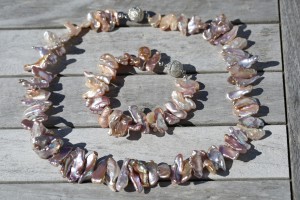SOUTH SEA CULTURED PEARLS
South Sea cultured pearls are large and breathtaking beautiful. They are known for their rarity and especially for their size, which can range from 8 to 18 mm – occasionally even larger – having a thick layer of nacre. They are also prized for their rare, attractive golden colors and variety of shapes, such as rounded, oval, button and baroque. Perfectly round or drop shapes are especially rare and therefore more sought after.
South Sea cultured pearls, which display color variations ranging from white through cream, champagne through yellow and all shades of gold, descend mainly from two varieties of the Pinctada Maxima oyster: the gold-lipped and grey-lipped. These pearls are cultured along the divide between the Indian and Pacific Oceans, the best-known white pearls of this type being harvested along the coast of eastern Malaysia.
These pearls are notably larger than the “average” pearls, and are stunningly smooth and round. They are likely the rarest and most extraordinary pearls to be found in jewelry.
The South Sea pearls come from the oyster pinctada maxima, which is a white-lipped type of the mollusk. The oyster is quite large about 32 cm in diameter, much larger than the oysters that produce Freshwater and Akoya pearls, which explains the larger size of South Sea pearls. Due to the rarity and sensitivity of the pinctada maxima, the farming of South Sea pearls is quite challenging, and thus the pearls are costly as it is very labor intensive to produce.
To produce the South Sea pearls, pearl farmers implant beads made of mother of pearl in the hopes that the conditions, and a bit of luck will allow for a perfectly round, lustrous, clean, and beautiful South Sea pearl.
The conditions for Pinctada Maxima are perfect in Malaysia because the water is clean the temperature is perfect, to create beautiful south sea pearls.
KESHI PEARLS AND ‘KESHI’ CULTURED PEARLS
Originally, Japanese farmers adopted the term Keshi to describe these tiny self-nucleated pearls that had grown by accident and were often found inside mollusks at harvest time. Today ‘Keshi’ cultured pearls form as a result of a bead-nucleus rejection during the cultivation of a saltwater pearl. They usually display an odd, baroque shape. ‘Keshi’ pearls have a nacreous layer structure and are considered to be cultured. ‘Keshi’ cultured pearls can grow to quite a size in the South Sea and Tahitian varieties.
Keshi pearls are quite unique in the way they are formed, when compared to the standard method of pearl formation.
There are two ways that the Keshi pearl can form, none of which has to do with the “usual” process. The first way that the keshi pearl can form occurs when the oyster rejects and spits out the substance – the nucleus – before the development of the pearl has had the opportunity to finish. The second possibility is that the nucleus fractures and forms two separate pearl sacs – that is, circles of nacre – neither with a nucleus. Eventually, one or two nucleus-less pearls will usually form.
Keshi pearls – means poppy seed in Japanese – the ones sold by Mutara are saltwater pearls. Keshi pearls also come in a variety of different colors and shades, and are known for their luster and uncommon orient. This is a result of their composition consisting of solid nacre. As the nucleus is eventually expelled by the oyster before the pearl is actually formed, the keshi pearl consists entirely of nacre.
Though this is true, keshi pearls are not given the classification of being a natural pearl. The reason is that keshi pearls are actually a bi-product of the culturing process, and not something that happens naturally.
The South Sea Keshi, pearls are considered to be much more exceptional and infrequent. The reason for this is that South Sea pearl farmers now x-ray their oysters to see whether or not the nucleus is still inside, or if it has been expelled. Should an oyster be found which has expelled its nucleus, it is re-nucleated before a keshi pearl would have the opportunity to develop. Thus the keshi pearls have become even more rare than they once were.
Still, keshi pearls remain popular as they are made of solid nacre and therefore usually have quite a bright luster. Their variable shapes are frequently considered quite desirable to jewelers who wish to design something unique and innovative.

